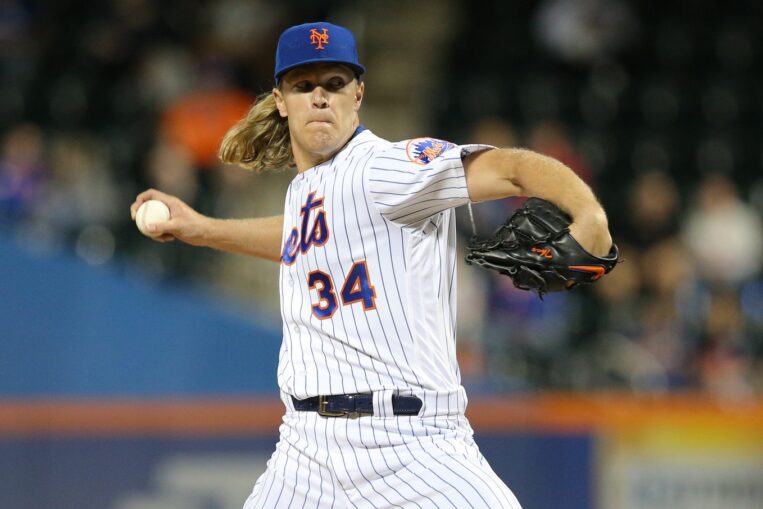
During the 2018 season, the New York Mets’ starting rotation consistently dominated the quality-of-contact categories when facing opposing hitters. That helped engineer a rebound in productivity from the year prior — after posting a cumulative 7.9 fWAR in 2017, that number jumped all the way up to 18.0 the following season.
The 2019 iteration of the Mets’ starting staff was once again one of baseball’s best (19.7 fWAR, third in MLB). That got me wondering if they used a similar approach to achieve those results. According to the FanGraphs leaderboards, that’s exactly what happened.
New York’s starting hurlers generated soft contact at a 19.5% clip, which ranked just behind the Boston Red Sox and Washington Nationals for tops in the league, who checked in at 19.6%. When looking at hard contact, nobody limited it more at the outset of games than the Mets, who finished with a 32.4% clip (the Nats finished with the second-best mark at 33.0%).
So what was different? What was the same? How are things looking heading into 2020, especially with Zack Wheeler out on the open market and no guarantee that he returns? Those are all good questions.
Pitchers Who Did The Heavy Lifting
It shouldn’t be surprising that in most cases when breaking down the Mets’ rotation performance, a majority of the production came from a small group of hurlers. That group typically consists of Wheeler, Noah Syndergaard, and Jacob deGrom. This trio once again saw success in their respective quality-of-contact numbers throughout 2019, even if some of them (mostly thinking about Wheeler and Syndergaard) had their share of ups and downs with regard to overall production (when looking at traditional statistics, at least).
Here’s a look at the soft-hit rate and hard-hit rate allowed for all New York starters who accumulated at least 50 innings pitched this past season:

DeGrom, Syndergaard, and Wheeler didn’t all finish in the top three for either category, but they’re the only ones that appeared among the top four in each instance. And although they weren’t toward the top of the MLB leaderboard as much as last year, their 2019 results still weren’t all that shabby.
When looking at qualified pitchers with the highest soft-hit rates in baseball, deGrom and Syndergaard both landed in the top five, while Wheeler was within the top 15. Upon switching gears to analyze the hard-hit rate leaderboard, these three all landed in the top six among qualified hurlers.
So this is kind of a good reason why the Mets should be doing everything they can to re-sign Wheeler after he rejected the $17.8 million qualifying offer (as expected). Sure, the price tag won’t be a cheap one, but it’s also a matter of looking past 2020. New York wants to be consistently competitive, and both the Houston Astros and Washington Nationals just showed the value of having an elite rotation.
There doesn’t seem to be a lot of help coming from the upper minors at the moment. Plus, other impact members of the current rotation mix are getting closer to free agency: Syndergaard and Steven Matz can hit the open market after 2021, while Marcus Stroman‘s final year of team control is 2020. With some uncertainty on the horizon, it’d be helpful to have certainty at the top of the Mets’ rotation with deGrom and Wheeler locked up beyond this time period.
Changes in Overall Pitch Mix?
The Mets earned similar results in the quality-of-contact department in each of the last two years — that much we’ve established. But has there been any huge changes in pitch mix on a cumulative basis? After all, hurlers began throwing sliders at a much higher rate in the second half when compared to the first half of play.
Here’s how the pitch mix of the Mets’ entire rotation compares to one another over the last two seasons:

There are obviously some differences going on here, and that second-half increase in slider usage this past season certainly made an impact. However, for the most part, there isn’t anything earth-shattering going on here. Even with Dave Eiland getting the axe and Phil Regan taking over as pitching coach in the middle of the season, the plan of attack from a pitch usage basis didn’t change all that much.
Free Agents That Fit This Mold
We can dissect the free-agent starting pitching market in a million different ways. But if we look hard at quality of contact and who excelled in one or both of soft-hit and hard-hit rate allowed, there are a number of hurlers that pop up.
The obvious ones are a trio of Scott Boras clients: Stephen Strasburg, Gerrit Cole, and Hyun-Jin Ryu. Each of these hurlers produced a better soft-hit rate than Wheeler, while only Strasburg had a lower hard-hit rate allowed (don’t worry, the other two weren’t too far behind). New York realistically pursuing and actually signing one of these three was already a long shot, and it’s even more of a long shot when knowing they only have about $20 million of spending room before hitting the $208 million luxury tax threshold.
Three more affordable names that jump out on these lists include the likes of Rick Porcello, Ivan Nova, and Dallas Keuchel. If we want to look a little deeper down these leaderboards, Kyle Gibson and Wade Miley are also hanging out.
That’s not the most inspiring group of available hurlers, but such is life when there isn’t a ton of spending capacity (read: willingness) available. One can assume that if Wheeler signs elsewhere, the Mets will either go bargain hunting or opt for plucking either Seth Lugo or Robert Gsellman from the bullpen.
None of those secondary options sounds ideal, but it might be the world New York will be living in for 2020.















